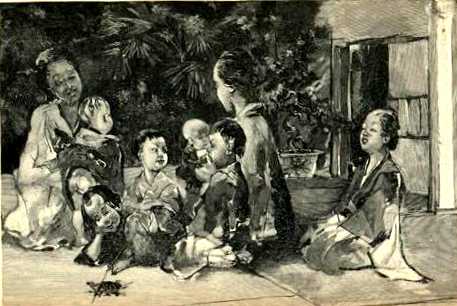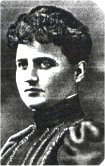| Jinrikisha Days in Japan (1899):
Upon the Bluff [of Yokohama]
stand a public hall, United States and British marine hospitals, a
French and a German hospital, several missionary establishments, and
the houses of the large American missionary community. At the
extreme west end a colony of Japanese florists has planted toy-gardens
filled with vegetable miracles; burlesques and fantasies of
horticulture; dwarf-trees, a hundred years old, that could be put in
the pocket; huge single flowers, and marvelous masses of smaller
blossoms; cherry-trees that bear no cherries; plum-trees that bloom in
midwinter, but have neither leaves nor fruit; and roses -- that
favorite flower which the foreigner brought with him -- flowering in
California profusion. A large business is done in the exportation
of Japanese plants and bulbs, encased in a thick coating of mud, which
makes an air-tight case to protect them during the sea-voyage.
Ingenious fern pieces are preserved in the same way. These
grotesque things are produced by wrapping in moist earth the long,
woody roots of a fine-leafed variety of fern. They are made to
imitate dragons, junks, temples, boats, lanterns, pagodas, bells,
balls, circles, and every familiar object. When bought they look
dead. If hung for a few days in the warm sun, and occasionally
dipped in water, they change into feathery, green objects that grow
more and more beautiful, and are far more artistic than our one
conventional hanging-basket. The dwarf-trees do not stand
transportation well, as they either die or begin to grow rapidly. (pg.
11)

"Japanese Children" (pg. 17)
The plum is the poet's tree,
and symbolic of long life, the snowy blossoms upon the gnarled, mossy,
and unresponsive branches showing that a vital current still animates
it, and the heart lives. At New-years a dwarf-plum is the
ornament of every home, and to give one is to wish your friend length
of days. Ume, the plum blossom, has a fresh, delicate,
elusive, and peculiar fragrance, which in the warm sun and open air is
almost intoxicating, but in a closed room becomes heavy and cloying.
(pg. 32)
A colony of
florists [near Shiba, in Tokyo, the old monastery grounds that are now
a public park and where some of the ashes of Tokugawa Shoguns reside]
show gardens full of wonderful plants and dwarf-trees... (pg. 49)
In the change from the
Chinese method of reckoning to the Gregorian, the Japanese January fell
to a churlish mood of nature, when only late chrysanthemums, camellias,
and in-door dwarf-trees can bloom. But every door-way is then
arched with evergreens and flowers; pine and bamboo, bound with braided
straw ropes, are set before the house; tassels of rice straw are
festooned across the eaves, and lanterns hang in rows. (pp. 65-66)
The [Kameido] temple [in
Tokyo] is ancient, and the grounds are full of tiny shrines, stone
lanterns, tablets, and images, and dwarfed and curiously trained
pine-trees, with a high, hump-backed little bridge, over which, in the
old days, only priests and grandees might walk. (pg. 78) 2
|

